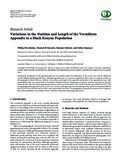Variations in the Position and Length of the Vermiform Appendix in a Black Kenyan Population

View/
Date
2014Author
Mwachaka, Philip
El-busaidy, Hemed
Sinkeet, Simeon
Ogeng'o, Julius A
Language
enMetadata
Show full item recordAbstract
Background. Topography of the appendix influences its mobility, degree of mobilization of the cecum, and need for additional muscle splitting during appendectomy. Although appendectomy is a common surgical procedure, there is a paucity of data on its topography in black Africans. Methods. The position and length of the appendix and relation of the appendicular base with spinoumbilical line were determined in 48 cadavers obtained from the Department of Human Anatomy, University of Nairobi, Kenya. Results. The commonest appendicular types in males were retrocecal 10 (27%) while in females was subileal 4 (36.4%). The average length of the appendix was 76.5 ± 23.6 mm. The base of the appendix was located along, below, and above the spinoumbilical line in 25 (52.1%), 9 (18.8%), and 14 (29.2%) cases, respectively. Conclusion. The topography of appendix in Kenyans shows variations from other populations. Knowledge of these variations is important during appendicectomy
Citation
ISRN Anatomy Volume 2014 (2014)Publisher
Hindawi Publishing Corporation
